













If your boat breaks down or ends up stranded, the costs of getting it back to shore or removing it after an accident can be steep. Many boat owners assume towing and salvage are automatically included in their insurance — but that’s not always the case.
Boat insurance coverage for towing and salvage varies by insurer, policy type, and location. Understanding the difference between these services, and when they may be covered, can help you avoid unexpected bills.
Towing
Marine towing refers to moving your disabled boat from the water to a safe harbor or dock. Common reasons include mechanical failure, dead batteries, or running out of fuel.
Salvage
Salvage is the process of recovering a boat that has sunk, run aground, or otherwise needs removal to prevent damage to property or the environment. This is typically a more complex — and more expensive — operation than towing.
Many standard boat insurance policies offer towing coverage, but it’s often an optional add-on.
Towing coverage may help pay for:
Important: Policies may set per-incident or annual maximums. Some insurers partner with towing service providers like TowBoatUS or Sea Tow.
Salvage coverage is usually separate from towing and may be included in hull coverage. It can help pay for:
Because salvage operations can run into the tens of thousands of dollars, some insurers cover it up to the boat’s insured value, while others limit it to a percentage of that value.
Boat insurance may cover towing and salvage, but terms vary widely. Towing is often an add-on, while salvage is usually tied to hull coverage. Understanding the difference — and your policy’s limits — can save you from big out-of-pocket costs when something goes wrong on the water.
Disclaimer: This article provides general information and is not legal or insurance advice. Coverage availability, terms, limits, and costs vary by insurer, policy, and location. Always confirm your specific coverage details with a licensed insurance provider before making decisions.
